Citroen C3 PICASSO RHD 2014 1.G Owner's Manual
Manufacturer: CITROEN, Model Year: 2014, Model line: C3 PICASSO RHD, Model: Citroen C3 PICASSO RHD 2014 1.GPages: 288, PDF Size: 8.38 MB
Page 141 of 288
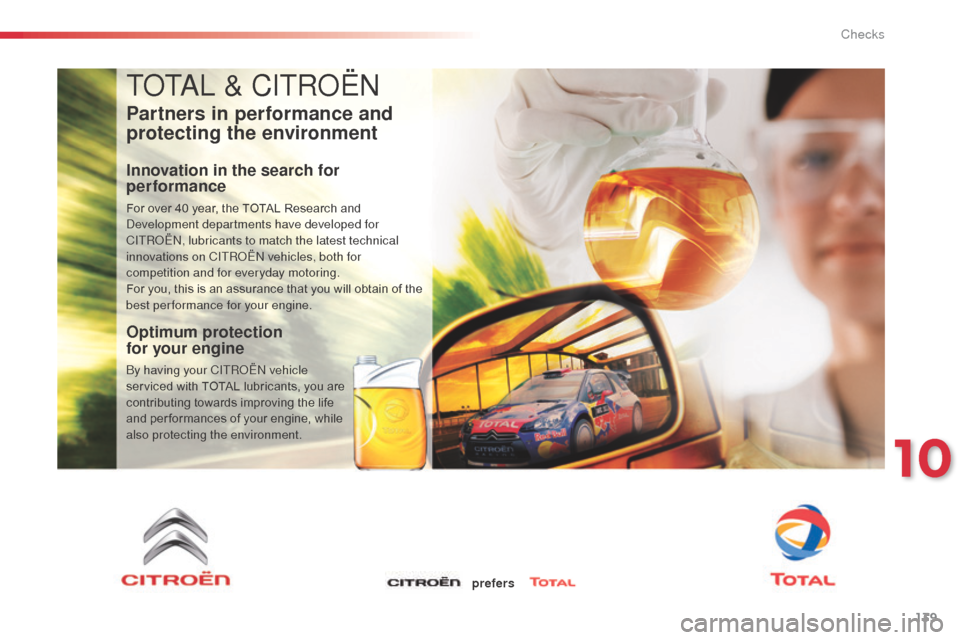
139
ToTaL & CITRoËn
Partners in performance and
protecting the environment
Innovation in the search for
performance
For over 40 year, the TOTAL Research and development departments have developed for
CITR
oËn, l
ubricants to match the latest technical
innovations on CITR
oËn
vehicles, both for
competition and for everyday motoring.
For you, this is an assurance that you will obtain of the
best performance for your engine.
Optimum protection
for your engine
by having your CITRoËn vehicle
serviced with TOTAL lubricants, you are
contributing towards improving the life
and per formances of your engine, while
also protecting the environment.
prefers
10
Checks
Page 142 of 288
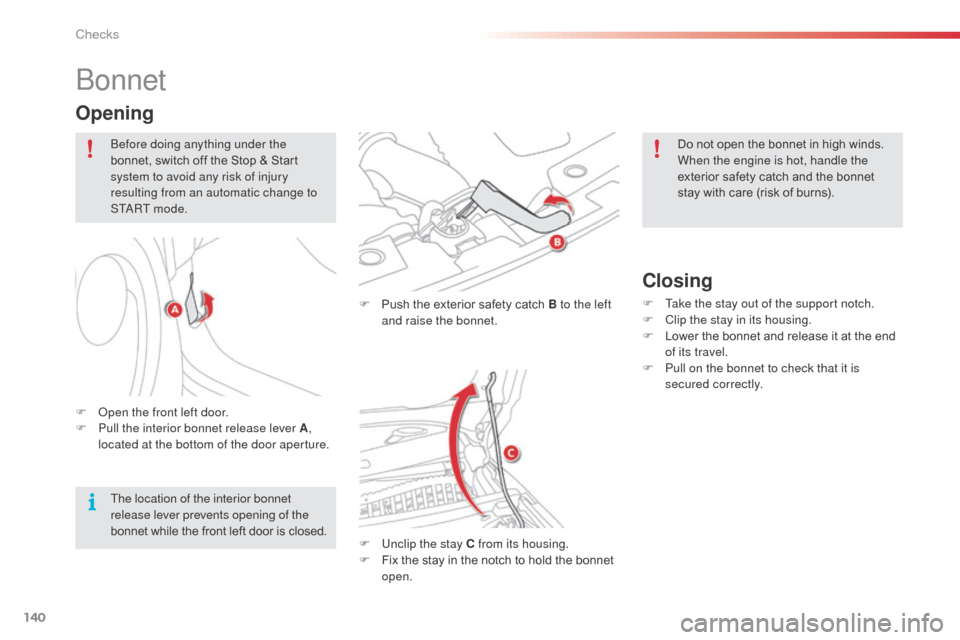
140
bonnet
F Push the exterior safety catch B to the left and raise the bonnet.
F
U
nclip the stay C from its housing.
F
F
ix the stay in the notch to hold the bonnet
open.
Closing
F Take the stay out of the support notch.
F C lip the stay in its housing.
F
L
ower the bonnet and release it at the end
of its travel.
F
P
ull on the bonnet to check that it is
secured correctly.
F
o
p
en the front left door.
F
P
ull the interior bonnet release lever A ,
located at the bottom of the door aperture.
Opening
before doing anything under the
bonnet, switch off the Stop & Start
system to avoid any risk of injury
resulting from an automatic change to
S T
a
R
T m o d e .
The location of the interior bonnet
release lever prevents opening of the
bonnet while the front left door is closed. Do not open the bonnet in high winds.
When the engine is hot, handle the
exterior safety catch and the bonnet
stay with care (risk of burns).
Checks
Page 143 of 288
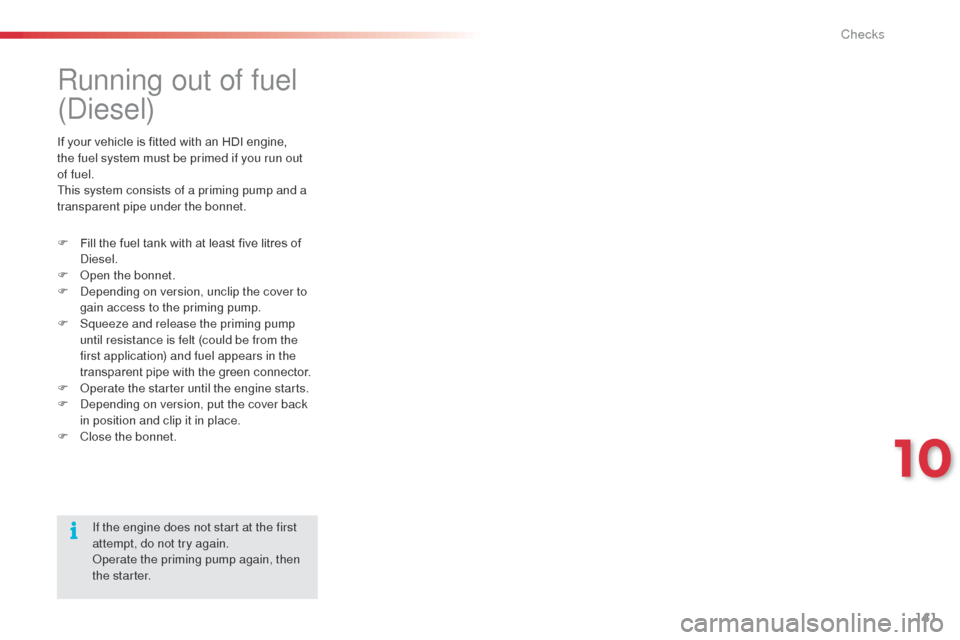
141
Running out of fuel
(
die
sel)
F Fill the fuel tank with at least five litres of die
sel.
F
o
p
en the bonnet.
F
d
e
pending on version, unclip the cover to
gain access to the priming pump.
F
S
queeze and release the priming pump
until resistance is felt (could be from the
first application) and fuel appears in the
transparent pipe with the green connector.
F
o
p
erate the starter until the engine starts.
F
d
e
pending on version, put the cover back
in position and clip it in place.
F
C
lose the bonnet.If the engine does not start at the first
attempt, do not try again.
op
erate the priming pump again, then
the starter.
If your vehicle is fitted with an HDI engine,
the fuel system must be primed if you run out
of fuel.
This system consists of a priming pump and a
transparent pipe under the bonnet.
10
Checks
Page 144 of 288
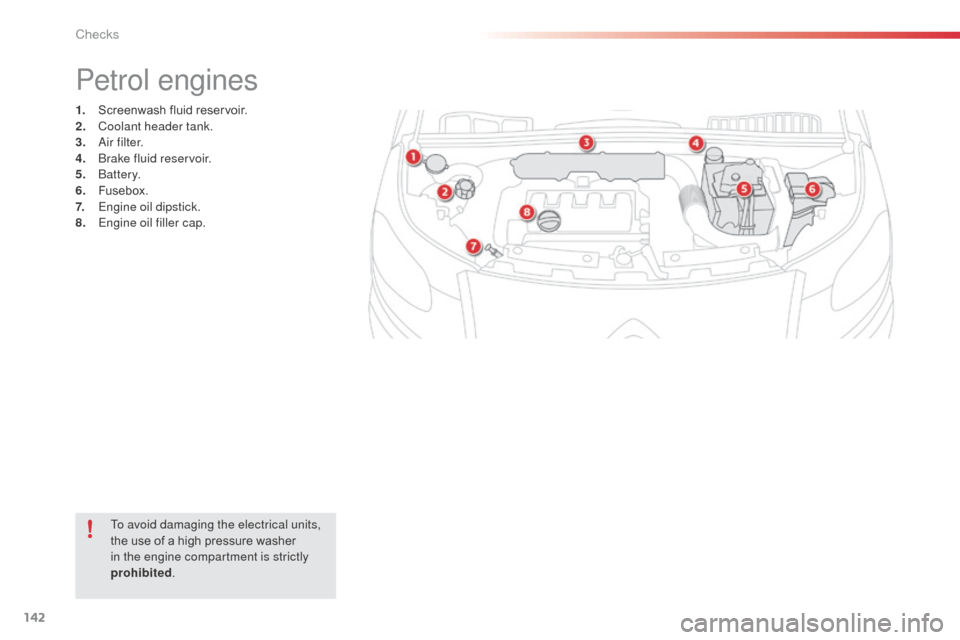
142
Petrol engines
1. Screenwash fluid reservoir.
2. Coolant header tank.
3.
a
i
r f i l t e r.
4.
b
r
ake fluid reservoir.
5.
bat
tery.
6.
F
usebox.
7.
E
ngine oil dipstick.
8.
E
ngine oil filler cap.
To avoid damaging the electrical units,
the use of a high pressure washer
in the engine compartment is strictly
prohibited .
Checks
Page 145 of 288
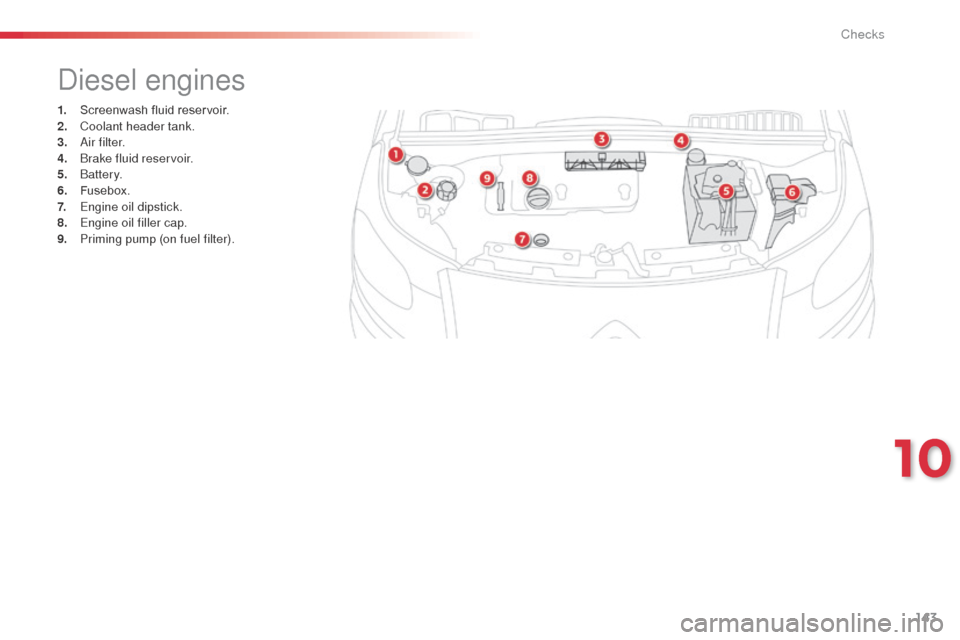
143
diesel engines
1. Screenwash fluid reservoir.
2. Coolant header tank.
3.
a
i
r f i l t e r.
4.
b
r
ake fluid reservoir.
5.
bat
tery.
6.
F
usebox.
7.
E
ngine oil dipstick.
8.
E
ngine oil filler cap.
9.
P
riming pump (on fuel filter).
10
Checks
Page 146 of 288
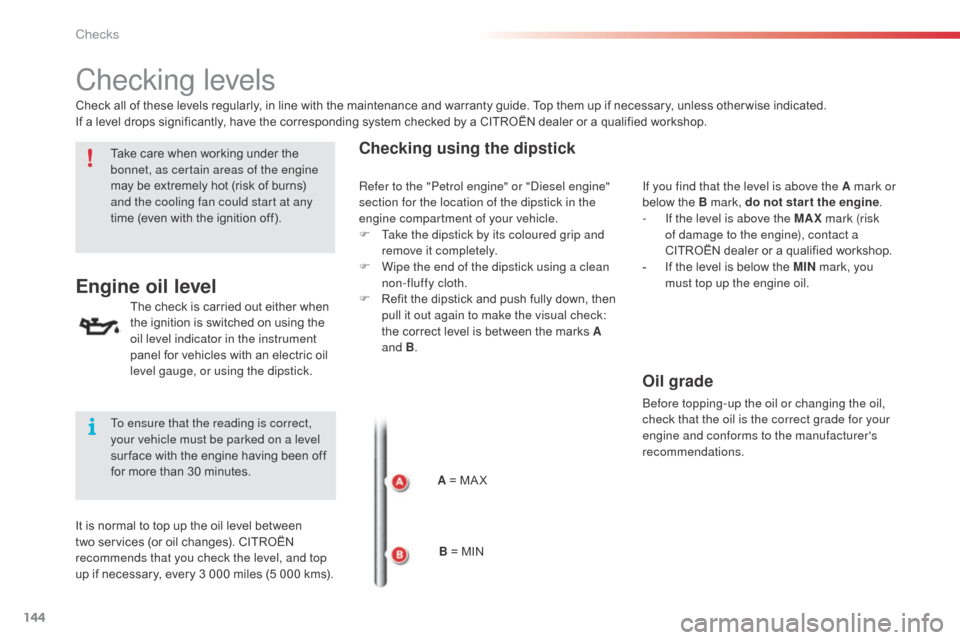
144
Checking levels
Engine oil level
The check is carried out either when
the ignition is switched on using the
oil level indicator in the instrument
panel for vehicles with an electric oil
level gauge, or using the dipstick.
Checking using the dipstick
A = MA X
Check all of these levels regularly, in line with the maintenance and warranty guide. Top them up if necessary, unless other wise indicated.
If a level drops significantly, have the corresponding system checked by a CITROËN dealer or a qualified workshop.
Take care when working under the
bonnet, as certain areas of the engine
may be extremely hot (risk of burns)
and the cooling fan could start at any
time (even with the ignition off).
To ensure that the reading is correct,
your vehicle must be parked on a level
sur face with the engine having been off
for more than 30 minutes.
It is normal to top up the oil level between
two services (or oil changes). CITROËN
recommends that you check the level, and top
up if necessary, every 3 000 miles (5 000 kms). B = MINIf you find that the level is above the A mark or
below the B mark, do not star t the engine
.
-
I
f the level is above the MAX
mark (risk
of damage to the engine), contact a
CITROËN dealer or a qualified workshop.
-
I
f the level is below the MIN
mark, you
must top up the engine oil.
Oil grade
before topping-up the oil or changing the oil,
check that the oil is the correct grade for your
engine and conforms to the manufacturer's
recommendations.
Refer to the "Petrol engine" or "
di
esel engine"
section for the location of the dipstick in the
engine compartment of your vehicle.
F
T
ake the dipstick by its coloured grip and
remove it completely.
F
W
ipe the end of the dipstick using a clean
non-fluffy cloth.
F
R
efit the dipstick and push fully down, then
pull it out again to make the visual check:
the correct level is between the marks A
and B .
Checks
Page 147 of 288
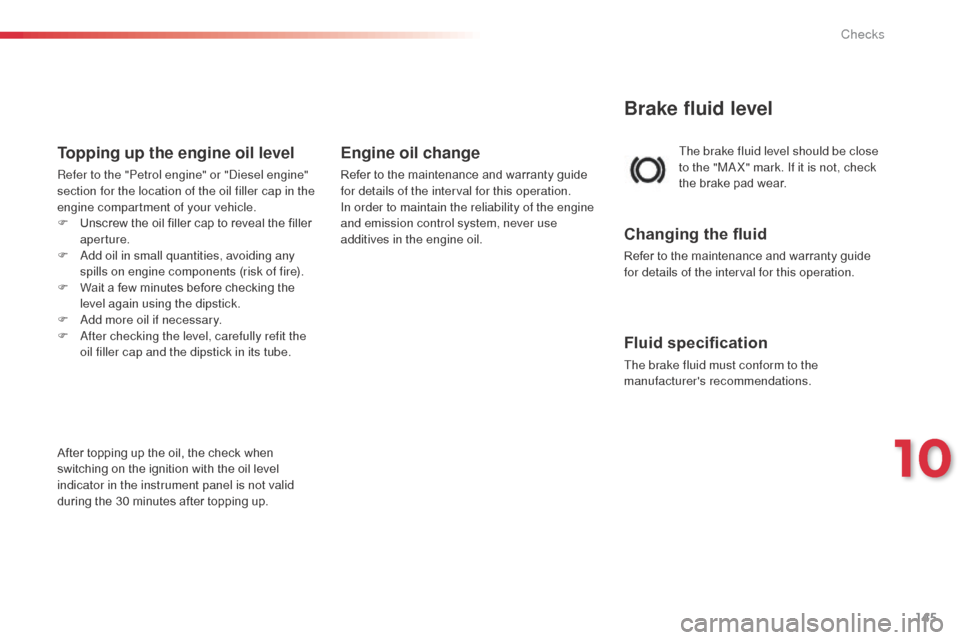
145
Brake fluid level
The brake fluid level should be close
to the "MaX" mark. If it is not, check
the brake pad wear.
Changing the fluid
Refer to the maintenance and warranty guide
for details of the interval for this operation.
Fluid specification
The brake fluid must conform to the
manufacturer's recommendations.
Topping up the engine oil level
Refer to the "Petrol engine" or "di esel engine"
section for the location of the oil filler cap in the
engine compartment of your vehicle.
F
U
nscrew the oil filler cap to reveal the filler
aperture.
F
a
d
d oil in small quantities, avoiding any
spills on engine components (risk of fire).
F
W
ait a few minutes before checking the
level again using the dipstick.
F
a
d
d more oil if necessary.
F
a
f
ter checking the level, carefully refit the
oil filler cap and the dipstick in its tube.
After topping up the oil, the check when
switching on the ignition with the oil level
indicator in the instrument panel is not valid
during the 30 minutes after topping up.
Engine oil change
Refer to the maintenance and warranty guide
for details of the interval for this operation.
In order to maintain the reliability of the engine
and emission control system, never use
additives in the engine oil.
10
Checks
Page 148 of 288
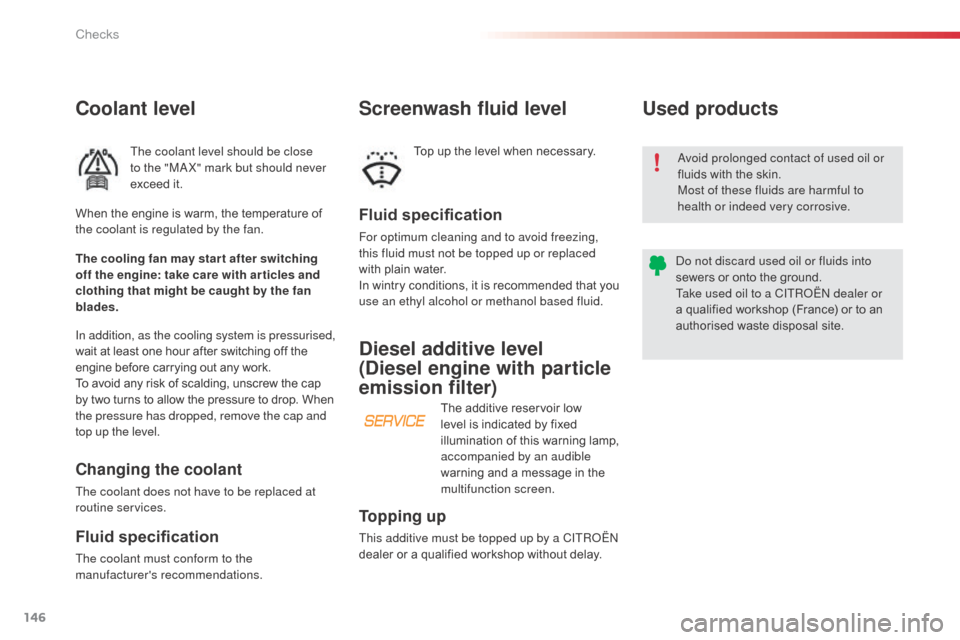
146
Coolant level
The coolant level should be close
to the "MaX" mark but should never
exceed it.
Fluid specification
For optimum cleaning and to avoid freezing,
this fluid must not be topped up or replaced
with plain water.
In wintry conditions, it is recommended that you
use an ethyl alcohol or methanol based fluid.
Fluid specification
The coolant must conform to the
manufacturer's recommendations.
Changing the coolant
The coolant does not have to be replaced at
routine services.
Screenwash fluid level
When the engine is warm, the temperature of
the coolant is regulated by the fan. Top up the level when necessary.
The cooling fan may star t after switching
off the engine: take care with ar ticles and
clothing that might be caught by the fan
blades.
In addition, as the cooling system is pressurised,
wait at least one hour after switching off the
engine before carrying out any work.
To avoid any risk of scalding, unscrew the cap
by two turns to allow the pressure to drop. When
the pressure has dropped, remove the cap and
top up the level.
Diesel additive level
(Diesel engine with particle
emission filter) Used products
To p p i n g u p
This additive must be topped up by a CITRoËn
dealer or a qualified workshop without delay.
av
oid prolonged contact of used oil or
fluids with the skin.
Most of these fluids are harmful to
health or indeed very corrosive.
do n
ot discard used oil or fluids into
sewers or onto the ground.
Take used oil to a CITR
oËn
dealer or
a qualified workshop (France) or to an
authorised waste disposal site.
The additive reservoir low
level is indicated by fixed
illumination of this warning lamp,
accompanied by an audible
warning and a message in the
multifunction screen.
Checks
Page 149 of 288
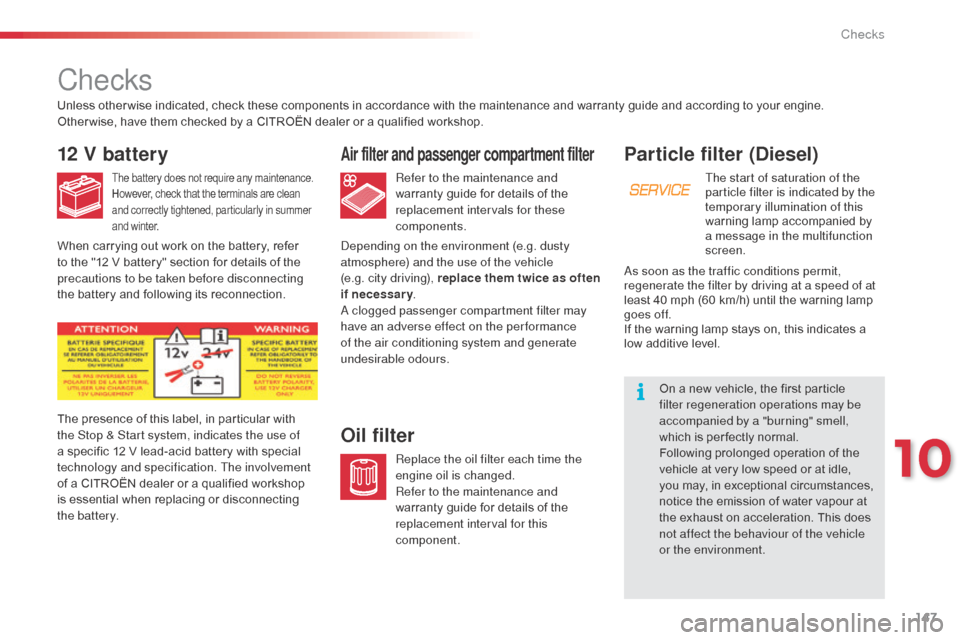
147
Particle filter (Diesel)
The start of saturation of the
particle filter is indicated by the
temporary illumination of this
warning lamp accompanied by
a message in the multifunction
screen.
On a new vehicle, the first particle
filter regeneration operations may be
accompanied by a "burning" smell,
which is per fectly normal.
Following prolonged operation of the
vehicle at very low speed or at idle,
you may, in exceptional circumstances,
notice the emission of water vapour at
the exhaust on acceleration. This does
not affect the behaviour of the vehicle
or the environment.
Checks
12 V battery
The battery does not require any maintenance.
However, check that the terminals are clean
and correctly tightened, particularly in summer
and winter.
Air filter and passenger compartment filter
Refer to the maintenance and
warranty guide for details of the
replacement intervals for these
components.
Oil filter
Replace the oil filter each time the
engine oil is changed.
Refer to the maintenance and
warranty guide for details of the
replacement interval for this
component.
Unless other wise indicated, check these components in accordance with the maintenance and warranty guide and according to your engine.
Other wise, have them checked by a CITROËN dealer or a qualified workshop.
When carrying out work on the battery, refer
to the "12 V battery" section for details of the
precautions to be taken before disconnecting
the battery and following its reconnection.
The presence of this label, in particular with
the Stop & Start system, indicates the use of
a specific 12 V lead-acid battery with special
technology and specification. The involvement
of a CITROËN dealer or a qualified workshop
is essential when replacing or disconnecting
the battery.
de
pending on the environment (e.g. dusty
atmosphere) and the use of the vehicle
(e.g. city driving), replace them twice as often
if necessary .
a c
logged passenger compartment filter may
have an adverse effect on the per formance
of the air conditioning system and generate
undesirable odours.
as s
oon as the traffic conditions permit,
regenerate the filter by driving at a speed of at
least 40 mph (60 km/h) until the warning lamp
goes off.
If the warning lamp stays on, this indicates a
low additive level.
10
Checks
Page 150 of 288
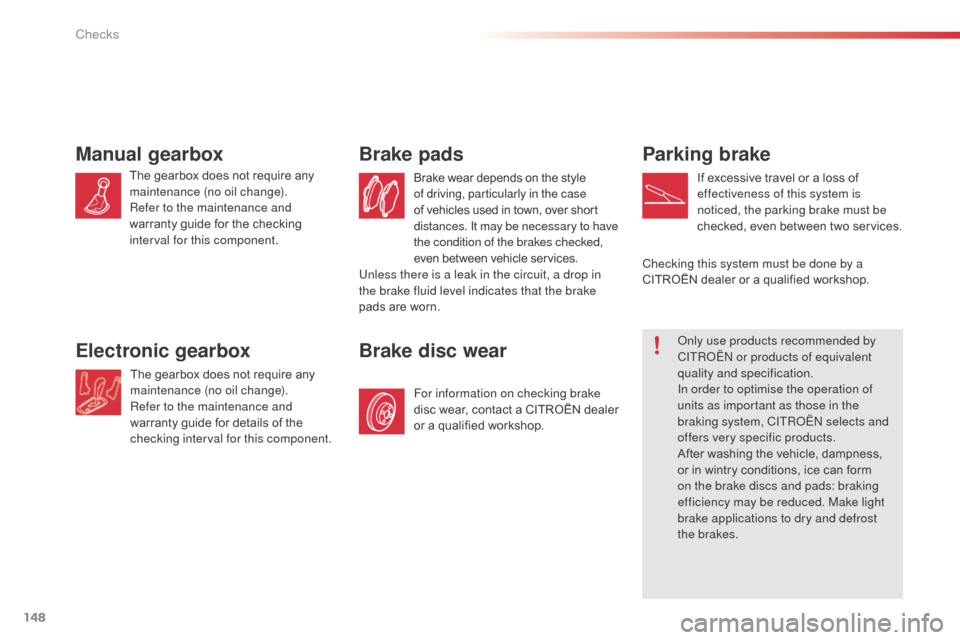
148
Parking brake
If excessive travel or a loss of
effectiveness of this system is
noticed, the parking brake must be
checked, even between two services.
Manual gearbox
The gearbox does not require any
maintenance (no oil change).
Refer to the maintenance and
warranty guide for the checking
interval for this component.For information on checking brake
disc wear, contact a CITROËN dealer
or a qualified workshop.
Brake disc wear
Brake wear depends on the style
of driving, particularly in the case
of vehicles used in town, over short
distances. It may be necessary to have
the condition of the brakes checked,
even between vehicle services.
Brake pads
The gearbox does not require any
maintenance (no oil change).
Refer to the maintenance and
warranty guide for details of the
checking interval for this component.
Electronic gearboxonly use products recommended by
CITRoËn or products of equivalent
quality and specification.
In order to optimise the operation of
units as important as those in the
braking system, CITR
oËn
selects and
offers very specific products.
After washing the vehicle, dampness,
or in wintry conditions, ice can form
on the brake discs and pads: braking
efficiency may be reduced. Make light
brake applications to dry and defrost
the brakes.
Checking this system must be done by a
CITROËN dealer or a qualified workshop.
Unless there is a leak in the circuit, a drop in
the brake fluid level indicates that the brake
pads are worn.
Checks